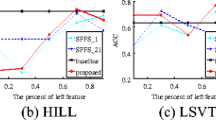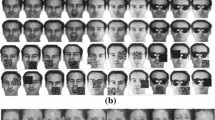Abstract
Since large amounts of labeled high-dimensional data needed to be processed, supervised feature learning has become an important and challenging problem in machine learning. Conventional supervised methods often adopt ℓ 2-norm loss function, which is sensitive to the outliers. However, real world data always contain lots of outliers that make traditional supervised methods fail to achieve the optimal performance. In addition, these methods can not reconstruct the original complex structured data well, since the dimensions of their learned projection matrices are often limited to the number of classes and are sub-optimal. To address these challenges, we propose a novel robust discriminative feature learning (RDFL) method via calibrated data reconstruction and sparse low-rank model. Specifically, RDFL preserves the discriminant information and simultaneously reconstructs the complex low-rank structure by minimizing joint ℓ 2,1-norm reconstruction error and within-class distance. To solve the proposed non-smooth problem, we derive an efficient optimization algorithm to soften the contributions of outliers. Meanwhile, we adopt the general power iteration method (GPIM) to accelerate our algorithm to make it scalable to large scale problem and theoretically analyze the convergence and computational complexity of the proposed algorithm. Extensive experimental results present that our proposed RDFL outperforms other compared methods in most cases and significantly improve the robust performance to noise and outliers.






Similar content being viewed by others
Explore related subjects
Discover the latest articles, news and stories from top researchers in related subjects.Notes
References
Belkin M, Niyogi P (2003) Laplacian eigenmaps for dimensionality reduction and data representation. Neural Comput 15(6):1373–1396
Bishop CM (1995) Neural networks for pattern recognition. Oxford University Press, Oxford
Cai D, Zhang C, He X (2010) Unsupervised feature selection for multi-cluster data. In: Proceedings of the 16th ACM SIGKDD conference on knowledge discovery and data mining. ACM, New York, pp 333–342
Cai X, Ding C, Nie F, Huang H (2013) On the equivalent of low-rank linear regressions and linear discriminant analysis based regressions. In: 1124–1132. ACM, New York
Fukunaga K (2013) Introduction to statistical pattern recognition. Academic Press, Cambridge
Golub GH, Van Loan CF (2012) Matrix computations, vol 3. Johns Hopkins University Press, Baltimore
Gong P, Zhou J, Fan W, Ye J (2014) Efficient multi-task feature learning with calibration. In: Proceedings of the 20th ACM SIGKDD international conference on knowledge discovery and data mining. ACM, New York, pp 761–770
Gorodnitsky IF, Rao BD (1997) Sparse signal reconstruction from limited data using focuss: a re-weighted minimum norm algorithm. IEEE Trans Signal Process 45(3):600–616
Gower JC, Dijksterhuis GB (2004) Procrustes problems, vol 30. Oxford University Press on Demand, Oxford
He X, Cai D, Niyogi P (2006) Laplacian score for feature selection. In: Weiss Y, Schölkopf PB, Platt JC (eds) Advances in neural information processing systems 18. http://papers.nips.cc/paper/2909-laplacian-score-for-feature-selection.pdf. MIT Press, pp 507–514
Hou C, Nie F, Li X, Yi D, Wu Y (2014) Joint embedding learning and sparse regression: a framework for unsupervised feature selection. IEEE Trans Cybern 44(6):793–804
Jiang YG, Ye G, Chang SF, Ellis D, Loui AC (2011) Consumer video understanding: a benchmark database and an evaluation of human and machine performance. In: Proceedings of the 1st ACM international conference on multimedia retrieval, vol 29. ACM, New York
Lewis DD (1992) Feature selection and feature extraction for text categorization. In: Proceedings of the workshop on speech and natural language. Association for Computational Linguistics, pp 212–217
Li H, Jiang T, Zhang K (2006) Efficient and robust feature extraction by maximum margin criterion. IEEE Trans Neural Netw 17(1):157–165
Li J, Cheng K, Wang S, Morstatter F, Trevino RP, Tang J, Liu H (2016) Feature selection: A data perspective. arXiv preprint arXiv:1601.07996
Liu H, Setiono R (1995) Chi2: feature selection and discretization of numeric attributes Proceedings of international conference on tools with artificial intelligence. IEEE, New York, pp 388–391
Liu H, Wang L, Zhao T (2014) Multivariate regression with calibration. In: Ghahramani Z, Welling M, Cortes C, Lawrence ND, Weinberger KQ (eds) Advances in neural information processing systems. Curran Associates, Inc., pp 127–135. http://papers.nips.cc/paper/5630-multivariate-regression-with-calibration.pdf
Loog M, Duin RPW, Haeb-Umbach R (2001) Multiclass linear dimension reduction by weighted pairwise fisher criteria. IEEE Trans Pattern Anal Mach Intell 23(7):762–766
Luo T, Hou C, Yi D, Zhang J (2016) Discriminative orthogonal elastic preserving projections for classification. Neurocomputing 179:54–68
Moore B (1981) Principal component analysis in linear systems: controllability, observability, and model reduction. IEEE Trans Autom Control 26(1):17–32
Nie F, Huang H, Cai X, Ding CH (2010) Efficient and robust feature selection via joint ℓ 2,1-norms minimization. In: Lafferty JD, Williams CKI, Shawe-Taylor J, Zemel RS, Culotta A (eds) Advances in neural information processing systems 23. Curran Associates, Inc., pp 1813–1821. http://papers.nips.cc/paper/3988-efficient-and-robust-feature-selection-via-joint-l21-norms-minimization.pdfhttp://papers.nips.cc/paper/3988-efficient-and-robust-feature-selection-via-joint-l21-norms-minimization.pdfhttp://papers.nips.cc/paper/3988-efficient-and-robust-feature-selection-via-joint-l21-norms-minimization.pdf
Peng H, Long F, Ding C (2005) Feature selection based on mutual information criteria of max-dependency, max-relevance, and min-redundancy. IEEE Trans Pattern Anal Mach Intell 27(8):1226–1238
Robnik- v Sikonja M, Kononenko I (2003) Theoretical and empirical analysis of relieff and rrelieff. Mach Learn 53 (1-2):23–69
Roffo G, Melzi S (2016) Features Selection via Eigenvector Centrality. In: Proceedings of new frontiers in mining complex patterns (NFMCP 2016)
Roffo G, Melzi S (2017) Ranking to learn: feature ranking and selection via eigenvector centrality. arXiv preprint arXiv:1704.054091704.05409
Saeys Y, Inza I, Larrañaga P (2007) A review of feature selection techniques in bioinformatics. Bioinformatics 23(19):2507–2517
Schönemann P H (1966) A generalized solution of the orthogonal procrustes problem. Psychometrika 31 (1):1–10
Schönemann P H (1968) On two-sided orthogonal procrustes problems. Psychometrika 33(1):19–33
Soltanolkotabi M, Elhamifar E, Candes EJ et al (2014) Robust subspace clustering. Ann Stat 42 (2):669–699
Wright J, Ganesh A, Rao S, Peng Y, Ma Y (2009) Robust principal component analysis: exact recovery of corrupted low-rank matrices via convex optimization. In: Advances in neural information processing systems 22. Curran Associates, Inc., pp 2080–2088. http://papers.nips.cc/paper/3704-robust-principal-component-analysis-exact-recovery-of-corrupted-low-rank-matrices-via-convex-optimization.pdfhttp://papers.nips.cc/paper/3704-robust-principal-component-analysis-exact-recovery-of-corrupted-low-rank-matrices-via-convex-optimization.pdfhttp://papers.nips.cc/paper/3704-robust-principal-component-analysis-exact-recovery-of-corrupted-low-rank-matrices-via-convex-optimization.pdf
Xu H, Caramanis C, Sanghavi S (2010) Robust PCA via outlier pursuit. In: Advances in neural information processing systems 23. Curran Associates, Inc., pp 2496–2504. http://papers.nips.cc/paper/4005-robust-pca-via-outlier-pursuit.pdf
Yang Y, Shen HT, Ma Z, Huang Z, Zhou X (2011) ℓ 1,2-norm regularized discriminative feature selection for unsupervised learning. In: Proceedings of international joint conference on artificial intelligence, vol 22, no1, pp 1589–1594
Ye J, Xiong T (2006) Computational and theoretical analysis of null space and orthogonal linear discriminant analysis. J Mach Learn Res 7:1183–1204
Acknowledgements
This work was supported by the National Science Foundation of China (No. 61473302 and No. 61503396) and NSF III-1421057.
Author information
Authors and Affiliations
Corresponding author
Rights and permissions
About this article
Cite this article
Luo, T., Yang, Y., Yi, D. et al. Robust discriminative feature learning with calibrated data reconstruction and sparse low-rank model. Appl Intell 54, 2867–2880 (2024). https://doi.org/10.1007/s10489-017-1060-7
Published:
Issue Date:
DOI: https://doi.org/10.1007/s10489-017-1060-7




